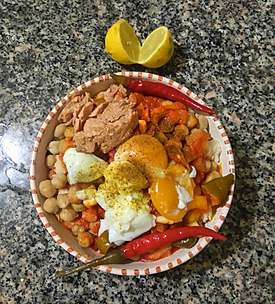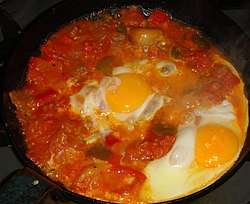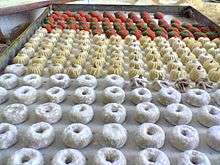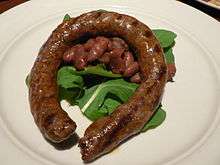Tunisian cuisine
Tunisian cuisine, the cuisine of Tunisia, is a blend of Mediterranean and Berber cuisines. Its distinctive spiciness comes from the many civilizations which have ruled the land now known as Tunisia: Romans, Vandals, Byzantines, Arabs, Spanish, Turkish, Italians (Sicilians), French, and the native Punics-Berber people. Many of the cooking styles and utensils began to take shape when the ancient tribes were nomads. Nomadic people were limited in their cooking implements by what pots and pans they could carry with them. The Tunisian tagine, is very different from the Algerian or Moroccan dish. It is a type of a pie dish, made out of eggs, meat and vegetables, similar to the Italian frittata or the eggah.


Like many countries in the Mediterranean basin, the Tunisian cuisine is heavily based on olive oil, spices, tomatoes, seafood and meat.
Origins
Tunisian cuisine developed from ancient Carthage, Rome, the Islamic conquest of the Maghreb, and the Ottoman Empire. The cuisine has been strongly influenced by French and Italian (especially Sicilian) cooking.[1]
Ingredients

Unlike other North African cuisines, Tunisian food is quite spicy. A popular condiment and ingredient which is used extensively in Tunisian cooking, harissa, is a mix of ground chili peppers, garlic, and spices commonly sold together as a paste. It is usually the most important ingredient in different sauces and gravies. Westernised harissa mostly contains red chilies to replace "black cumin" which is different from standard cumin. Other common spices include cumin or cumin seeds, garlic, caraway seeds, coriander seeds and paprika. A recipe for the sauce includes red chili peppers and garlic, flavored with coriander, cumin, olive oil and often tomatoes.
Like harissa or chili peppers, tomato paste is also an ingredient integral to the cuisine of Tunisia. Tuna, eggs, olives and various varieties of pasta, cereals, herbs and spices are also ingredients which are prominently used in Tunisian cooking.
Tunisian culinary ingredients include the following typical elements:[2]
- Condiments and flavorings: harissa, rose water, orange blossom water, jasmine water and geranium water.
- Eggs.
- Farm animals: lamb, veal, beef, camel and chicken.
- Fish and seafood: tuna, squid (calamari), octopus, anchovies, eel, sardines, mackerel, red snapper, sea bream, sea snails and sea bass.
- Fruits: lemon, oranges, figs, dates, olives, apricots, pomegranates and quince.
- Herbs: parsley, cilantro, mint, basil, rosemary, oregano, bay leaves and thyme.
- Nuts: hazelnuts, almonds, chestnuts, pine nuts and peanuts.
- Spices: garlic, anise, saffron, cinnamon, caraway, coriander, cumin, fennel, fenugreek, ginger, white pepper, black pepper, red pepper and cloves.
- Vegetables: onions, bell peppers, carrots, chickpeas, tomatoes, capers, celery, turnips, potatoes, chili peppers, cucumbers and eggplants.
- Other popular ingredients: honey.
Tunisians also produce grapes, wheat, barley and orchard fruits, once fermented they become wines, as in Chateau Mornag which is a staple Tunisian wine, beers (Celtia, Berber or the Stella brand - now owned by Heineken of the Netherlands), brandy (Boukha - fig liqueur, Thibarine - herbal date liqueur, or other liqueurs made from pomegranates, dates, lotos (jujube), carobs or prickly pears) and apple ciders. Scented waters with dark rose or blossom petals, similar to aguas frescas with flowers, have been called "scents from heaven".
Tabil, pronounced "tebel," is a word in Tunisian Arabic meaning "seasoning" (similar to 'adobo' in Spanish) and now refers to a particular Tunisian spice mix, although earlier it only meant ground coriander. Paula Wolfert makes the plausible claim that tabil is one of the spice mixes brought to Tunisia by Muslims coming from Andalusia in 1492 after the fall of Granada. Today, tabil, closely associated with the cooking of Tunisia, features garlic, cayenne pepper, caraway seeds and coriander pounded in a mortar, then dried in the sun. It is often used in cooking beef, veal and game.
Due to the long coastline and numerous fishing ports, seafood has a prominent place in Tunisian cuisine. Fish can also be grilled, baked, fried, or stuffed and seasoned with cumin (kamoun). Squid, cuttlefish and octopus are served in hot crispy batter with slices of lemon, in a cooked salad, or stuffed and served with couscous.
Regional cuisines
Tunisia has different regional aspects. Tunisian cuisine varies from north to south, from the coast to the Atlas Mountains, from urban areas to the countryside, and along religious affiliations.
For instance, the original inhabitants of Tunis (the Beldiya), do not use harissa much; they prefer milder food, and have also developed their own breads and desserts.
Closer to the Atlas mountain range, game is favoured. A diet may be composed of quail, pigeons, squabs, partridge, rabbits and hare. In the Cap Bon, people enjoy tuna, anchovies, sardines, sea bass and mackerels. On the island of Djerba, where there is a dense Jewish presence, Kosher food is consumed. In Hammamet, snails are enjoyed. Organs are traditionally staples of Tunisian cooking, such as tripe, lamb brains, beef liver and fish heads.
Despite the strong presence of fast food and restaurants in Sfax, people from the city enjoy their traditional dishes more than anything else. Sfaxians tend to add their own touch to the Tunisian cuisine. They have staple regional dishes such as "The Marka" which is a fish soup to which Sfaxians usually add vermicelli or couscous. The soup can also be eaten with barley bread or croutons. "The Charmoula" is also another dish made out mainly of baked raisins and onions and spices and it is traditionally eaten with salted fish on the First day of Eid al-Fitr. Sfax is also famed for its pastries. There are two kinds of Sfaxian pastries: daily pastry (locally called "hlou Arbi") like Makrouth, Doria, and Ghraiba, and high-range pastry for weddings and special ceremonies (like Baklawa, mlabbes and Ka'ak warka').[3]
In Djerba, kosher cuisine is available as well as a myriad of restaurants[4] offering a wide range of regional dishes like rouz djerbi and mainly seafood-based meals.
Main dishes
Couscous
Couscous, called "Kosksi", is the national dish of Tunisia, and can be prepared in many ways. It is cooked in a special kind of double boiler called a kiska:s in Arabic or couscoussière in French. The couscous used is typically fine-grained.
Meats, vegetables and spices are cooked in the lower pot. Cooking steam rises through vents into the container above. It is layered with whole herbs such as bay leaves and covered with a fine-grain couscous. The couscous pasta is therefore cooked with aromatic steam. During the cooking process, the couscous needs to be regularly stirred with a fork to prevent lumping, much as risotto is cooked.
Meats
Preferred meats include lamb (kosksi bil ghalmi) or chicken (kosksi bil djaj), but regional substitutes red snapper, grouper (kousksi bil mannani), sea bass (kosksi bil warqua), hare (kosksi bil arnab) or quail (kosksi bil hjall). Pork consumption is forbidden to Muslims in Tunisia, in accordance with Islamic dietary laws.
Tajine
Unlike Moroccan tajines, a tajine in Tunisia usually refers to a kind of "quiche", without a crust, made with beaten eggs, grated cheese, meat and various vegetable fillings, and baked like a large cake.
Seafood
A popular seafood specialty is the 'poisson complet' or the whole fish. The entire fish, excluding internal organs, is prepared and fire-grilled, but it can also be fried, grilled or sautéed. It is accompanied with potato chips and either mild or spicy Tastira. the latter is typically made by frying green peppers, tomatoes,onion and a little garlic, all of which is finely chopped and served with an egg poached or sunny side up. Finely chopped fresh parsley is sprinkled on top; a drizzle of lemon juice and a pinch of sea salt complete the recipe.
Sauces
Tunisian sauces, which are closer to spicy broths, are an integral part of dishes. Otherwise olive oils are often used as sauces.
This said, harissa or hrissa is often said to be a Tunisian sauce, but it is better described as an ingredient of Tunisian cooking or a seasoning. Harissa is made of red chili, garlic, salt, cumin, coriander, olive oil, and sometimes also caraway or mint.
Two Tunisian sauces deserve mentioning: the Kerkennaise sauce and the Mloukhia. The first is made of capers, olive oil, tomato, scallions, coriander, caraway, cumin, parsley, garlic, white vinegar and paprika. The latter is a dark green sauce served with shredded lamb or beef.
Dishes
.jpg)

- Asida – a sweet gruel pudding.
- Assidat Zgougou – an Aleppo pine pudding.
- Baklawa – layers of thin pastry interspersed with ground pine nuts, almonds, hazelnuts and pistachios, brushed in golden butter, baked and dipped in a honey syrup.
- Bambalouni – fried sweet donut–like cake served with sugar.
- Berber–style lamb stew – A simple stew of lamb cooked with vegetables, such as potatoes and carrots, in a traditional clay pot.
- Bouza – rich and sticky sorghum puree.
- Brik – tiny parcels of minced lamb, beef, or vegetables and an egg wrapped in thin pastry and deep fried.
- Chakchouka – a vegetarian ragout similar to ratatouille with chickpeas, tomatoes, peppers, garlic and onions, served with a poached egg.
- Chorba – a seasoned broth, with pasta, meatballs, fish, etc.
- Felfel mahchi – Sweet peppers stuffed with meat, usually lamb, and served with harissa sauce.
- Fricasse – tiny sandwich with tuna, harissa, olives and olive oil. It bears no similarity to the classic continental European casserole of the same name.
- Guenaoia – Lamb or beef stew with chillies, okra, and spices.
- Houria – cooked carrot salad.
- Kamounia – a beef and cumin stew
- Khobz Tabouna – traditional oven–baked bread. Tunisian Khobz Tabouna is not a flat or pita like bread.
- Koucha – shoulder of lamb cooked with turmeric and cayenne pepper.
- Lablabi – rich garlicky soup made with chickpeas.
- Langues d'oiseaux or "birds' tongues", a type of soup with pasta shaped like rice grains.
- Makroudh – semolina cake stuffed with dates or almonds, cinnamon and grated orange peel.
- Masfouf – sweetened couscous, the Tunisian version of the Moroccan seffa.
- Makboubeh – tomato and pepper stew.
- Makloub – a folded-pizza sandwich, similar to a shawarma, made from pizza dough and filled with minced chicken, cheese, salad, harissa, mayonnaise and other sauces.[5][6]
- Makoud – potato and meat casserole (similar to a quiche).
- Marqa – slow–cooked stews of meat with tomatoes and olives, somewhat similar in concept to the Moroccan tajine stews.
- Mechouia salad – an hors d'oeuvre of grilled sweet peppers, tomatoes and onions mixed with oil, lemon, tuna fish and hard–boiled eggs.
- Merguez – small spicy sausages.
- Mhalbiya – cake made with rice, nuts and geranium water.
- Mloukhia – a beef or lamb stew with bay leaves. The name is from the green herb used, which produces a thick gravy that has a mucilaginous (somewhat "slimy") texture, similar to cooked okra.
- Noicer pasta – very thin, small squares of pasta made with semolina and all–purpose flour, flavoured with Tunisian Bharat, a blend of ground cinnamon and dried rosebuds.
- Ojja – scrambled egg dish made of tomatoes and mild green chillies supplemented with various meats and harissa.
- Osbane – pieces of animal gut stuffed with meat and offal, a specialty from Monastir.
- Tunisian Salad – diced cucumber, peppers, tomatoes, and onions seasoned with olive oil. Maybe garnished with olives, eggs and tuna. Analogous to the French Niçoise salad and Greek salad.
- Samsa – layers of thin pastry alternated with layers of ground roast almonds, and sesame seeds, baked in lemon and rosewater syrup.
- Shakshouka – a dish of eggs poached in a sauce of tomatoes, chili peppers, and onions, often spiced with cumin.
- Zitounia – ragout of veal or other meats simmered in a tomato sauce with onions, flavoured with olives.
- Torshi – turnips marinated with lime juice.
- Yo-yo – donuts made with orange juice, deep fried, then dipped in honey syrup.
See also
References
- Alan Davidson (2014). Tom Jaine (ed.). The Oxford Companion to Food (3rd ed.). Oxford: Oxford University Press. p. 835. ISBN 0-19-967733-6.
- "Tunisian". Food. Retrieved 2017-04-11.
- "Sfaxian food-detail - Medcities - Mediterranean Cities Network". www.medcities.org. Retrieved 2017-04-13.
- Clarys, Hanna. "The 10 Best Restaurants In Djerba". Culture Trip. Retrieved 2017-04-19.
- Tunisian Makloub
- Things We Love: Makloub | Better Things Ahead
Further reading
- Tunisian cuisine article, from Vegetarian Times, July 2000 (Google Books)
- Recipe books
- Tunisia Mediterranean Cuisine, by: Konemann ISBN 3-8331-2344-3

